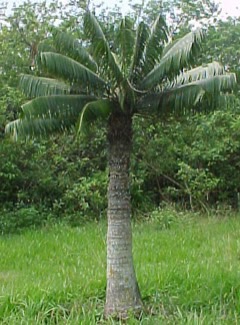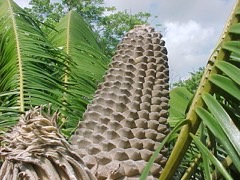 |
|
cybertruffle.org.uk/people/dminter |
 |
| cybertruffle.org.uk/people/dminter |
Translate this page:
Summary
Microcycas calocoma is one of the most ancient cycad species. It is endemic to a small area in western Cuba in Pinar del Río Province. Critically Endangered in the wild. The plants are affected by habitat destruction (moderate) and over collecting of plants from the wild.
Physical Characteristics

 Microcycas calocoma is an evergreen Perennial growing to 10 m (32ft) by 4 m (13ft) at a slow rate.
Microcycas calocoma is an evergreen Perennial growing to 10 m (32ft) by 4 m (13ft) at a slow rate.
See above for USDA hardiness. It is hardy to UK zone 10.
Suitable for: light (sandy), medium (loamy) and heavy (clay) soils and prefers well-drained soil. Suitable pH: mildly acid, neutral and basic (mildly alkaline) soils. It can grow in full shade (deep woodland) semi-shade (light woodland) or no shade. It prefers moist soil.
UK Hardiness Map
US Hardiness Map
Synonyms
Zamia calocoma Miq.
Plant Habitats
Edible Uses
References More on Edible Uses
Medicinal Uses
Plants For A Future can not take any responsibility for any adverse effects from the use of plants. Always seek advice from a professional before using a plant medicinally.
None Known
References More on Medicinal Uses
The Bookshop: Edible Plant Books
Our Latest books on Perennial Plants For Food Forests and Permaculture Gardens in paperback or digital formats.

Edible Tropical Plants
Food Forest Plants for Hotter Conditions: 250+ Plants For Tropical Food Forests & Permaculture Gardens.
More

Edible Temperate Plants
Plants for Your Food Forest: 500 Plants for Temperate Food Forests & Permaculture Gardens.
More

More Books
PFAF have eight books available in paperback and digital formats. Browse the shop for more information.
Shop Now
Other Uses
Carbon Farming Solutions - Industrial Crop: starch (Crops grown for non-food uses. Industrial crops provide resources in three main categories: materials, chemicals, and energy. Traditional materials include lumber and thatch, paper and cardboard, and textiles) [1-1]. Genera to investigate include: Cycas, Dioon, Encephalartos, Macrozamia, Microcycas, and Zamia [1-1]. Nearly all cycads fix low amounts of nitrogen. Ornamental - Landscape Uses: Specimen. An ornamental plant.
Special Uses
Carbon Farming
References More on Other Uses
Cultivation details
Hypothetical Crop Industrial Crop: Starch Management: Standard
Climate: tropical. Humidity: semi-arid to humid. Populations are scattered in both lowland and montane sites, the latter being in very rough terrain. The plants grow in three types of soils, Jurassic alkaline limestone, more-or-less sandy acidic soils underlaid with slate, and siliceous clays with a pH between 5.4 and 6.9 (slightly acid to slightly alkaline). The habitats vary from grasslands to, more commonly, pine or semi-deciduous forests and conditions range from full sun to deep shade. Carbon Farming Solutions - Cultivation: hypothetical. Management: standard (Describes the non-destructive management systems that are used in cultivation) [1-1].
Carbon Farming
-
Hypothetical Crop
These are perennial plants that could potentially be developed for cultivation. Some, such as cycads (for industrial starch), as simply neglected; others, such as buckwheat and soybeans, are annual crops that could potentially be perennialised by crossing and relatives.
-
Industrial Crop: Starch
Materials and chemicals include bioplastics, paper, cardboard, solvents, paints, glues etc. Plants are usually pods, starchy fruits, nuts & seeds, starchy trunks.
-
Management: Standard
Plants grow to their standard height. Harvest fruit, seeds, or other products. Non-Destructive management systems.
References Carbon Farming Information and Carbon Sequestration Information
Temperature Converter
Type a value in the Celsius field to convert the value to Fahrenheit:
Fahrenheit:
The PFAF Bookshop
Plants For A Future have a number of books available in paperback and digital form. Book titles include Edible Plants, Edible Perennials, Edible Trees,Edible Shrubs, Woodland Gardening, and Temperate Food Forest Plants. Our new book is Food Forest Plants For Hotter Conditions (Tropical and Sub-Tropical).
Shop Now
Plant Propagation
Seed
Other Names
If available other names are mentioned here
Palma corcho
Native Range
SOUTHERN AMERICA: Cuba (Pinar del Río)
Weed Potential
Right plant wrong place. We are currently updating this section.
Please note that a plant may be invasive in one area but may not in your area so it's worth checking.
None Known
Conservation Status
IUCN Red List of Threatened Plants Status : Status: Critically Endangered A2cd

Growth: S = slow M = medium F = fast. Soil: L = light (sandy) M = medium H = heavy (clay). pH: A = acid N = neutral B = basic (alkaline). Shade: F = full shade S = semi-shade N = no shade. Moisture: D = dry M = Moist We = wet Wa = water.
Now available:
Food Forest Plants for Mediterranean Conditions
350+ Perennial Plants For Mediterranean and Drier Food Forests and Permaculture Gardens.
[Paperback and eBook]
This is the third in Plants For A Future's series of plant guides for food forests tailored to
specific climate zones. Following volumes on temperate and tropical ecosystems, this book focuses
on species suited to Mediterranean conditions—regions with hot, dry summers and cool, wet winters,
often facing the added challenge of climate change.
Read More
Expert comment
Author
(Miq.) A.DC.
Botanical References
Links / References
For a list of references used on this page please go here
Readers comment
| Add a comment |
|
If you have important information about this plant that may help other users please add a comment or link below. Only comments or links that are felt to be directly relevant to a plant will be included. If you think a comment/link or information contained on this page is inaccurate or misleading we would welcome your feedback at [email protected]. If you have questions about a plant please use the Forum on this website as we do not have the resources to answer questions ourselves.
* Please note: the comments by website users are not necessarily those held by PFAF and may give misleading or inaccurate information.
To leave a comment please Register or login here All comments need to be approved so will not appear immediately.
|
Subject : Microcycas calocoma
|
|
|
|